AudioCulture
The noisy library of New Zealand music
Te pātaka korihi o ngā puoro o Aotearoa
Kim Hart
1980 was a year of highs and lows for Hart. The singer was signed to EMI Australia in March, but the day before she was about to get on the plane, to record her first Australian album, the police arrested her manager (and boyfriend) on a charge of drug importation.
In 2016, Hart told AudioCulture, “When they came to take him away, I was standing in the lounge thinking ‘what the ****?’ Somebody’s forgotten to tell me something!’ ”
Hart had a Top 10 Australian hit in August 1980 with ‘Love At First Night’.
The events Hart had not been told about happened a few years earlier, before she met Ainscough. “They thought he was Mr. Asia,” says Hart. “He was put on remand in Mt Eden, the day before I flew out to start my album in Sydney. He was there on remand for almost a month. He had bail set at $50,000. We had to get people to sign as surety. I had to zip around the hat and get five people to do that.”
In the midst of all this personal pressure, Hart had a Top 10 Australian hit in August 1980 with ‘Love At First Night’. The song has since gone on to become a rare groove disco track, recently appearing on the 2009 Disco Ladies CD in the highly-regarded “Disco Discharge” series on Harmless Records (UK).
On 10 August 1980, Hart hosted the Australian pop TV show Countdown. Watching it on YouTube, I wondered, why was Hart commuting to Australia from Auckland? Why didn’t she just go and live there, like everybody else does? The answer was that her manager, once he got bail, was unable to leave New Zealand until he was acquitted of the charge, nine months later.
Getting Started
Hart had started in music in her teen years, when she featured as a backing vocalist on TV producer Kevan Moore’s answer to The Sound Of Music, the super sweet Sing (1975). Hart also did one performance out front on the show. The singer attended Penrose High School with Tina Cross and both singers were in the school group Chalkdust, who were finalists in the 1976 Auckland Battle Of The Bands.
At 17, Kim Hart was signed to the Wellington-based EMI Records. The company chose Auckland arranger and songwriter Mike Harvey to produce her recordings at EMI’s Lower Hutt Studio. That same year she represented New Zealand at the 1977 Yamaha Song Contest in Tokyo, singing her first single, the ballad ‘You Don’t Need Me’ written by Mike Harvey. Hart returned to the event two years later, in November 1979, to sing with Steve Allen his song ‘Out of Control’. There were entries from 79 different countries and singers, including Eric Carmen (USA), Peter Noone (USA) and Bonnie Tyler (UK).
Hart sang Harvey’s composition ‘On My Toes’ in the South Pacific Song contest, making the finals. The song charted in New Zealand at No.41 on 20 October 1978.
In 1978 EMI released her debut album Kim Hart. The eclectic selections included some ‘Wild Night’ by Van Morrison, ‘How Deep Is Your Love’ by The Bee Gees and ‘Blame It On The Sun’ by Stevie Wonder, plus four songs by Harvey and one song each from Auckland songwriters Lea Maalfrid and Malcolm McCallum. The album did not chart in New Zealand but Hart won Most Promising Female Vocalist at the 1978 New Zealand Music Awards.
The Manager
When Graham Ainscough, a 32-year old son of a Wigan coal miner, appeared on the scene, Hart knew she had found the right man for the job. Her father had helped her, “just being Dad and very supportive,” says Hart, but Ainscough was her first manager. “Graham was very charming, that’s why I fell in love with him. He had the gift of the gab. He was totally interested in music and had an incredible energy.”
Hart’s new man and new manager made the very smart move to sign to EMI Australia. “I didn’t want a New Zealand contract,” Ainscough told Auckland Metro in August 1981. “At that time New Zealand record companies showed no panache when it came to handling artists.”
An Australian EMI A&R man, John Kerr, got on a plane to New Zealand to see Kim Hart and the singer signed a recording contract for one album per year for three years with a $10,000 signing fee, a $15,000 backing for her first single and $40,000 for production and promotion for the first album. The recording was to take place at EMI’s new $3m dollar Studio 301.
Hart’s profile increased with her new manager, but so did his profile rise as he featured in several stories focusing on how he masterminded the marketing of the singer. Ainscough was not content to stay in the background.
“I don’t think he purposely tried to get in the limelight,” says Hart. “He was interesting, charismatic. He was very upfront and outspoken. He didn’t set out to share the limelight.”
In August 1980 Kim Hart was on the cover of New Zealand’s Better Business magazine, dressed in a suit and tie, sitting at a desk with a copy of USA music biz magazine Cashbox in view. “Pop For Profit” was the headline, and the subhead read: “Kim Hart Inc. in the business of making music and money.” The story inside was heavily about Ainscough, and this very early example of taking the music business seriously got very Spinal Tap at times.
Ainscough told Better Business about buying a mare in foal to achieve a tax deduction for Kim Hart’s projected cash surplus. But the surplus did not eventuate, so they sold the horses at a profit. With a song in the Australian Top 10, the manager said, “We’ve got cash flow problems, Kim’s making a fortune but it’s all going on expenses.” (When he said the same to EMI boss David Snell he was told, “My company turned over $6m dollars last year and we’re in exactly the same position!“)
Some of the quotes in the story did not make Ainscough look good: “Like most people in the business I hate paperwork. I am so busy trying to work out what clothes Kim should wear in Whangarei or which song she should sing in Christchurch. I forgot to fill in the forms and write out cheques. I had to dash in once and pay the electricity bill in cash because they were on the way to cut it off!”
The story points out that Hart had the wisdom to realise that weekly gigs at the Mt Wellington Trust didn’t make a Donna Summer, Cleo Laine or Linda Ronstadt. Ainscough said Hart was “singing at an average of three places a night over the last year.”
The manager also featured prominently in the Auckland Metro story where the heading read, “My Product, My Wife – The Selling of Kim Hart.” But Hart had equal say in this story: “According to Graham I was the wrong shape, didn’t speak proper, had no discipline, dressed wrong and was generally a mess. When I think of the opinion he held of me I don’t even know why he bothered.”
It was boot camp time: “running, singing, articulating and rehearsing from dawn to dusk.”
Love At First Night
Hart’s relationship with EMI Australia got off to a great start. Kim Hart recorded the single ‘Love At First Night’ in March 1980 with top producer Russell Dunlop, who already had success with singer Jon English and would produce Phil Judd solo albums, The Reels and Mental As Anything in the 1980s.
By mid-year the singer had made three appearances on the very influential Countdown TV show and completed a three-week nationwide tour to promote the single. When Hart hosted Countdown, near the end of that showregular host Molly Meldrum joined her to interview the singer about her hit single. She then closed the show with her new single ‘You’re The One’. In total, Hart made six appearances on the Countdown show.
‘Love At First Night’ had a healthy 10-week run in the Australian Top 20 Singles Chart.
‘Love At First Night’ had a healthy 10-week run in the Australian Top 20 Singles Chart, including four weeks in the Top 10, peaking at No.6 on 28 July 1980. Even Australian rock magazine R.A.M. had good things to say about Hart’s single. After first writing that Hart was derivative of Australian pop singer Christie Allen, writer Lionel Lange continued: “[Allen was] perfect enough for EMI to clone via sultry Kim. When you get over the shock of this strategy you get a disco slouch suitable for high-rotation broadcast. Sloppy popularist pop. How disgusting! But be honest, we’re all pop music addicts, we love being exploited. If you don’t love this you’re dead already.”
An American, Alan Day, wrote ‘Love At First Night’. He had his own hit single ‘Skinny Girls’ in the Australian Top 20 at the same time. While Hart was in the chart, the Split Enz song ‘I Got You’ was on its way down from the No.1 spot and their single ‘I Hope I Never’ was on its way up.
With ‘Love At First Night’ still in the Top 20, in mid-August EMI released the follow-up single ‘You’re The One’. Two singles followed in 1980: ‘Feel Like Makin’ Love’ and ‘It’s So Easy’.
On 22 October, Hart commenced a 10-week tour as opening act for comedian Norman Gunston. The six nights a week tour (with two shows some nights) was expected to play to over 500,000 Australians. In November Hart opened for Roy Orbison on his New Zealand tour; the following month she opened for Elton John over three nights at the Perth Entertainment Centre.
No Album
Despite its long stay on the Australian sales charts, ‘Love At First Night’ did not quite achieve gold status at the time, but did sell a healthy 48,000 units. When Hart was in Auckland for the New Zealand Music Awards on 27 October 1980, she was awarded a gold disc for sales exceeding 7500 units. The follow-up singles achieved airplay in Australia, and some sales, but EMI Australia chose to not release the album that Hart had recorded. It had been scheduled for release at the end of 1980.
When asked in 2017 why the album was not released, Hart replied, “To this day, I still don’t know why.” The singer suggests reasons that may have influenced their decision, such as “Political stuff going on, Graham being in jail or my asking for an advance?”
For a career to move forward a record label has to have a good relationship with both the musician and that musician’s manager. If the manager is the musician’s husband, the record label is unlikely to take that musician aside and say “Can you get rid of this guy?”
“The friendship [with EMI] reached an uncomfortable situation,” says Hart. “And then it stopped – stalemate!”
Hart’s relationship with her manager had become public knowledge in 1980 and a December management press release on Kim Hart letterhead acknowledges that: “Despite the controversy surrounding her romantic involvement with her manager, her success continues …”
After 1980’s massive hit and Ainscough’s acquittal on drug importation charges, the couple married on 14 February 14 1981.
That year. EMI released the single ‘Young Girl’ but the album that was scheduled for release in 1980 disappeared from sight. Among the songs was Hart’s first attempt at writing, ‘Off By Hart’.
London
One of Ainscough’s innovative marketing moves was to get Hart involved in the marketing and advertisements for Yamaha motorcycles. The manager’s October 1980 press release identified his plans for the proceeds from the endorsement deal: “The money will be used to engage an International PR Company and to establish a business base in London in preparation for the assault on the European market planned for 1981.
In the 1981 Metro story Ainscough spoke of their plans to head for Europe and his interest in selling local songwriters: “We will be assailing the continental market with a bagful of songs by New Zealand songwriters. There is brilliant material buried away in bands [Harry Lyon, Dave McArtney etc]. I believe that some of the New Zealand material is so strong that with European producers and the right marketing we could have hit after hit.”
They went to London via an extensive, money-generating Australian tour with her band Sledge. They made the front cover of The West Australian on 18 August 1981 standing beside their equipment truck after it had been stolen and wrecked. Pictured are Ian Russell, Tony Marks and Kim Hart. The singer was nearing the end of the 18-week tour when the van was stolen from outside the Subiaco Hotel, Perth. “Someone stole the $7000 uninsured vehicle and drove it for three blocks before hitting a tree. The van was a write-off. To add to the group’s bad luck, about $2500 worth of sound and lighting equipment was stolen.”
In London, the couple’s relationship ended and Hart lived there during 1982 and 1983, performing at a Leicester Square Nightclub “and did a bit of bar work, as you do.”
Coolangatta Gold
In 1984 Hart got to sing the rocky ‘Heartbeat’ – co-written by Sharon O’Neill – from the movie Coolangatta Gold. (The soundtrack also includes a bar band playing Tim Finn’s ‘A Fraction Too Much Friction’.) She had wanted to move more towards rock, but no recording opportunities arose from exposure in the movie.
In 1985 Hart met her second husband Jay Stewart, who has been her partner for 32 years. They have two children: Jason (28) and Ella (21). Stewart, a TV music composer and keyboard player, was in Hart’s band when they did a nationwide tour of Australia with The Commodores in 1987. Stewart has also worked with Australian singers Marcia Hines and Rick Price.
Stewart’s composing work for TV included Hart as a singer on themes for Better Homes & Gardens, Who Dares Wins, What's Good For You and Popstars.
In the decade after Hart’s Top 10 hit there was regular club and TV work in Australia and Hart appeared – often singing live – on The Don Lane Show, The Midday Show, Hey Hey It’s Saturday etc.
One of her backing-vocal credits was ‘One Of The Good Guys’ and the title track on Marc Hunter’s 1994 album Talk To Strangers (Roadshow).
In 2006 and 2007, Hart was a backing vocalist on the Australian Idol TV show and in 2011 she was one of the vocalists featured in the “The First Ladies Of Soul” tribute show that debuted at Lizotte’s in Sydney. Hart stayed with the show for a year.
In 2017, The Kim Hart Band includes Jay Stewart on keyboards, Clive Lendich on guitar (Manhattan Transfer, Neil Sedaka), Emile Nelson on bass (Delta Goodrem, Kate Ceberano), Mitch Farmer on drums (Renee Geyer, Rick Price) and vocalist Lisa Croft (Rock Lobsters, L90).
Finding Hart for this story took several days as she was in Perth for the weekend with a covers band. The soundman in Perth had worked with her in the 1980s and he produced an old itinerary in which they did 29 dates in 31 days. Hart keeps busy, but has no desire to repeat that sort of schedule. “I have my own band, now I’m happy doing what I want to do, doing bits and pieces.”
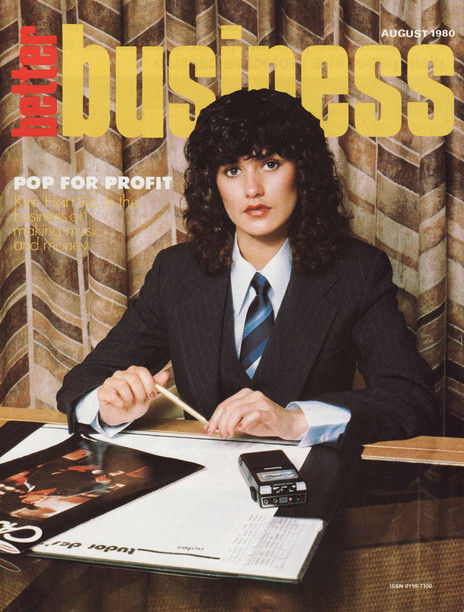
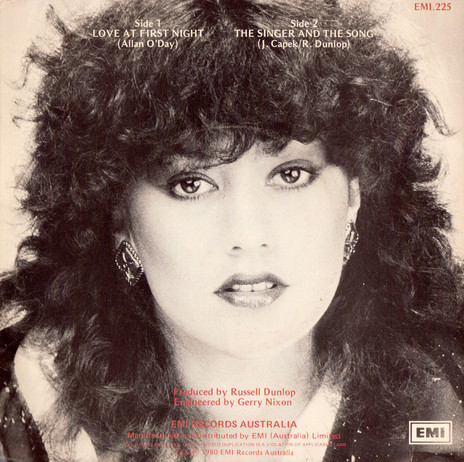
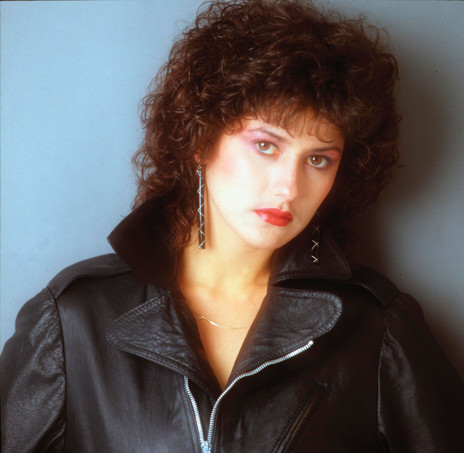
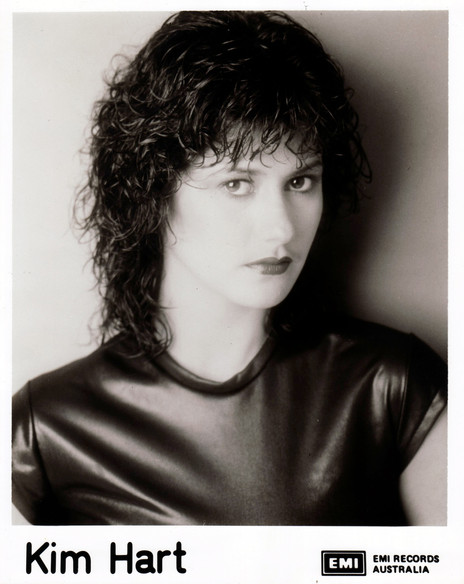
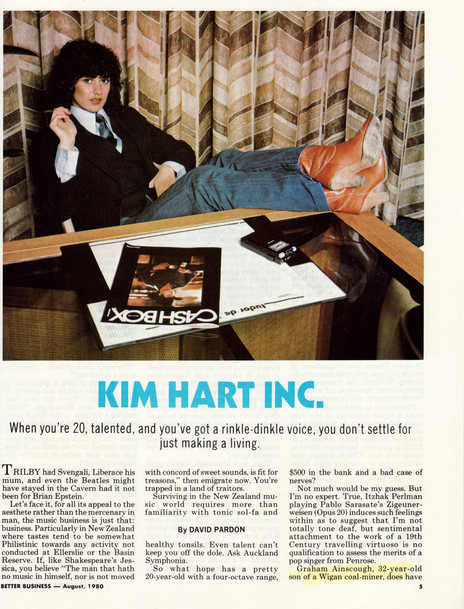

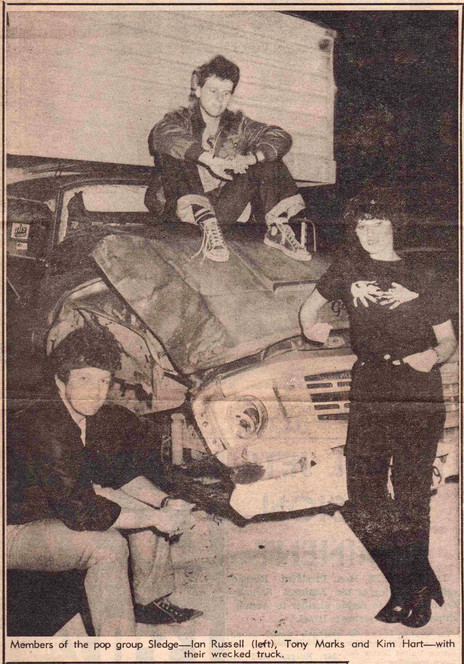
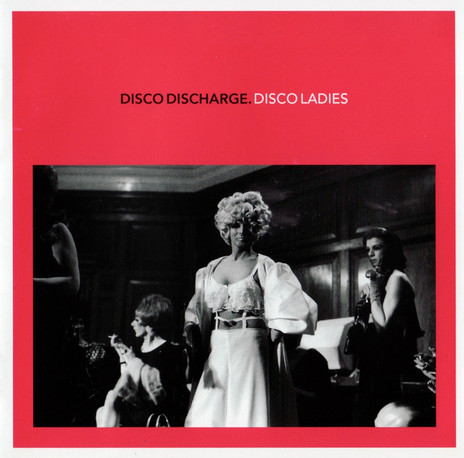
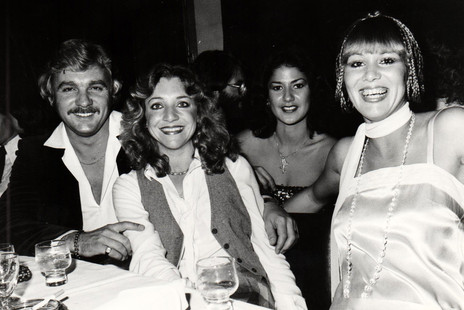
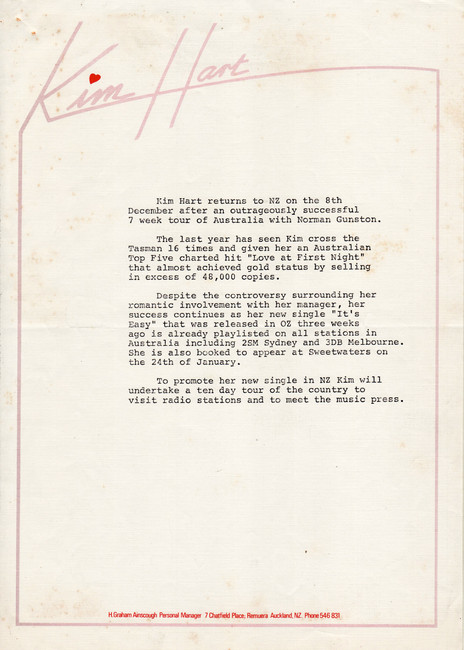
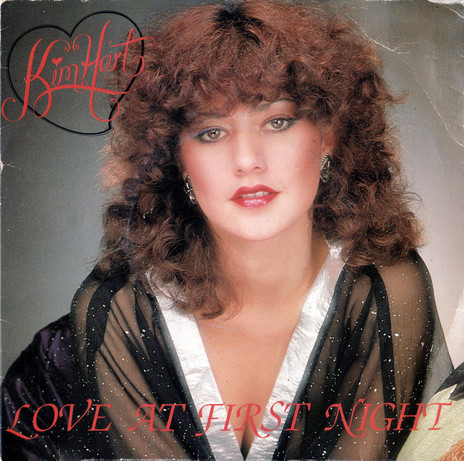
EMI
RCA
Visit our sister site
NZ On ScreenMade with funding from
NZ On Air


